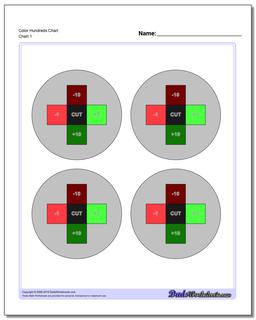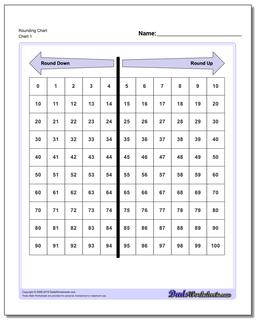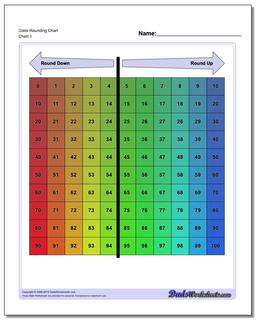Core Math Worksheets
Fraction Worksheets
Algebra
Other Worksheets
Place Value
Percentages
Rounding Numbers
Ordering Numbers
Standard, Expanded, Word Form
Mean Median Mode Range
Ratio Worksheets
Probability Worksheets
Roman Numerals
Factorization, GCD, LCM
Prime and Composite Numbers
Pre-Algebra
Geometry Worksheets
Blank Clocks
Telling Analog Time
Analog Elapsed Time
Greater Than and Less Than
Money
Arithmetic Sequences
Geometric Sequences
Venn Diagram
Graph Worksheets
Measurement & Conversions
Patterns and Puzzles
Color by Number
Holiday & Seasonal
Early Learning
Printables
Calculators
Math Worksheets by Grade
Worksheet News
Hundreds Chart
Every hundreds chart you could imagine! If you're teaching basic counting, number sense, rounding or the basics of arithmetic, you can use a number chart like one of these to speed up building math skills.
Hundreds Chart
4 Hundreds Charts
This is plain version of a printable 100s chart, including a number chart that is missing numbers as well as a blank hundreds chart that the student must fill in to use.
Hundreds ChartColor Hundreds Chart
4 Hundreds Charts
Liven it up with this color version of a printable 100s chart. The are versions of this number chart that are missing numbers, plus a completely blank hundreds chart for kids to fill in and use for reference.
Color Hundreds ChartThose basic hundreds charts will get you started, but for applications including skip counting, addition and subtraction strategies and more, be sure to check out the hundreds chart worksheets in the section below. If you're looking for more resources for teaching basic number sense and your students are ready to move on to multiplication facts, be sure to check out my multiplication chart page!
Hundreds Chart Skip Counting Practice
Hundreds Chart Addition Practice
Hundreds Chart Subtraction Practice
Hundreds Chart Multiplication Practice
Numbers and Words on the Hundreds Chart
Hundreds Chart Puzzles
Hundreds Chart Riddles
Hundreds Chart Tracing Numbers
100 Chart Tool
1 Hundreds Charts
Print these tools to navigate your 100 chart! You can use these cut out windows to move around the number chart and see the relationships between values as you move horizontally (+/- one) and vertically (+/- ten) on the chart.
100 Chart Tool120 Chart
4 Hundreds Charts
This is plain version of a printable 120 chart, including charts that are missing numbers as well as a blank 120 chart that the student must fill in to use.
120 ChartColor 120 Chart
4 Hundreds Charts
Liven it up with this color version of a printable 120 chart. The are versions of the charts that are missing numbers, plus a completely blank hundreds chart to fill in and use.
Color 120 ChartRounding Chart
4 Hundreds Charts
You can use a hundreds number chart to teach rounding! This printable chart gives you all of the values from 1-100 and shows clearly which way to go to get a rounded-off number.
Rounding ChartColor Rounding Chart
4 Hundreds Charts
Use colors to make rounding numbers a bit more interesting. This hundreds number chart uses colors to help guide students when rounding off numbers.
Color Rounding ChartHidden Pictures Puzzles
17 Hundreds Charts
Use these printable hidden pictures puzzles to master the hundreds chart! Each number corresponds to a color, and when kids color each number on the chart a picture is revealed.
Hidden Pictures Puzzles
How Printable Hundreds Charts Help Teach Number Skills
A hundreds chart can be used in many different ways to build number literacy, practice addition and subtraction skills, learn skip counting, and more. A hundreds chart is a useful companion to multiplication charts for learning the four arithmetic operations, and you should consider having both of these on hand when you start out teaching basic math facts.
The printable number charts here come in variations for 100 and 120 with versions of filled and blank hundreds charts that kids can also use as worksheets.
While many exercises were often performed with a basic 100s chart, you'll find often that kids fail to make the place value leap once they go over 100, and you'll get bizarre answers to questions like, 'What comes after 100?' including values like 200 or 110 or similar. Practicing with a 120s chart in these situations can help, and any of the exercises you'll perform with a typical hundreds chart will apply with a 120s chart as well.
How do you use a 100s chart?
You can use a hundreds chart to make kids comfortable with adding, subtracting, and even multiplying! For starters, just having kids count and identify the numbers on the chart is a great activity that helps them see and visualize the numbers. You may check our printable hundreds chart with words and numbers where underneath each number, is the number written in words. For example ’30’ and ‘thirty’.
One way to help establish that the numbers are a continuous sequence is to trim one edge of the number chart and roll it up, twisting it slightly so that the numbers from the previous row flow into the following ones, like this…
Not only is playing with a number tube fun, but it also shows how the numbers progress continuously and that they're not just arbitrary groups of 10 or rows on the chart.
Another great activity is to use these printable hundred chart window tools…

By understanding how moving up or down a hundreds chart involves adding or subtracting ten, and moving left or right involves adding or subtracting 1, kids can develop a great understanding of place value concepts. You can cut out those tools so that they either show only the number in the center or cut the horizontal and vertical flaps so that the students can pull them back to reveal the related numbers.
Another great hundreds chart activity is to cut up the chart into various odd shapes and let the kids put the chart back together again. It's an interactive way to explore how the numbers on the chart go together and reinforces the visual nature of the chart and how it relates to the pattern of numbers.
Rounding on the Hundreds Chart
The rounding charts are another great way a hundreds chart can be a resource for a sometimes confusing math topic. The rounding charts have a dividing line between the four and the five, and a large pair of arrows at the top that tell which way to round a number. The chart has the 'zeroes' place duplicated in the first and last column to make it clear which number you wind up with, so you can't use these charts in quite the same way as a traditional hundreds chart, but for learning how to round numbers these charts can be a lifesaver.
Skip Counting on Hundreds Chart
Beyond basic counting, you will notice that the hundreds chart has patterns and relationships especially when skip counting. I created a set of skip counting worksheets where students will be asked to skip count and fill in the chart. Worksheets with multiple-choice questions for skip counting are also available.
I also added multiplication worksheets that shows how a hundreds chart and multiplication are connected. A hundreds chart is a grid of numbers from 1 to 100, arranged in rows and columns. Multiplication, on the other hand, is a mathematical operation that combines two numbers to find their product. This set of worksheets will let students solve each multiplication problem using a hundreds chart.
Addition and Subtraction
The hundreds chart also plays a vital role in mastering addition and subtraction, so I created a set of worksheets for this too! Students can solve the equations by counting forward or backward on the chart. As students engage with the chart, they learn to recognize the relationships between numbers and develop mental math strategies. Addition becomes a seamless process as students count forward on the chart, while subtraction becomes an exercise in counting backward.
Puzzles and Riddles on Hundreds Chart
Finally, and perhaps the most fun, I've built a whole series of puzzles and riddles that students can use to get familiar with the hundreds chart. The first set of worksheets includes puzzles with hidden pictures that are revealed when students find specific numbers on the hundred charts and color them according to the instructions for each picture.
The second set of worksheets will ask students to figure out and write the missing numbers from the puzzles.
And the last set, riddles! No matter how young or old you are, you will enjoy the cognitive challenge this brain teaser worksheet gives.
Tips and Tricks For Using The Hundreds Chart Effectively
- Number Recognition: Use the hundreds chart to help young kids recognize and identify numbers. Point to a specific number and ask them to say it out loud. You may print the version with number words for starters and then the regular chart moving forward.
- Counting Practice: Use the skip counting worksheets or charts for counting practice. Start from a specific number and ask kids to count forward or backward, either by ones or by different intervals.
- Number Patterns: Encourage kids to look for patterns on the hundreds chart. For example, have them identify the rows or columns where certain numbers appear (e.g., all the multiples of 3, all the even numbers). Ask them to explain the patterns they observe.
- Addition and Subtraction: Practice addition and subtraction using the hundreds chart. Start with a number and ask kids to count forward or backward to find the sum or difference. For example, for 37 + 8, start at 37 and count forward 8 cells to reach the answer. Once they are ready, let them answer the addition and subtraction worksheets found on this page.
- Multiplication: Explore multiplication using the hundreds chart. Ask kids to find the product of a number by counting along rows or columns. For example, 4 multiplied by 3. Locate the first number (4) on the hundreds chart. Move horizontally to the right. Move your finger or a marker horizontally to the right from the starting number (4) for the number of times indicated by the second number (3). In this case, move three steps to the right. Read the final number. Once you have moved three steps to the right, you will land on a number. That number represents the product of the two numbers you are multiplying. In this example, you would land on the number 12. Therefore, 4 multiplied by 3 equals 12.
- Identifying Number Families: Help kids identify number families or fact families using the hundreds chart. Choose three numbers and ask them to find the corresponding addition and subtraction facts. For example, for the numbers 5, 2, and 7, they can find 5 + 2 = 7 and 7 - 2 = 5.
- Extensions and Challenges: Use the hundreds chart for more advanced activities. Explore concepts like prime numbers, factors, and multiples by asking kids to identify specific patterns or groups of numbers on the chart.




































































